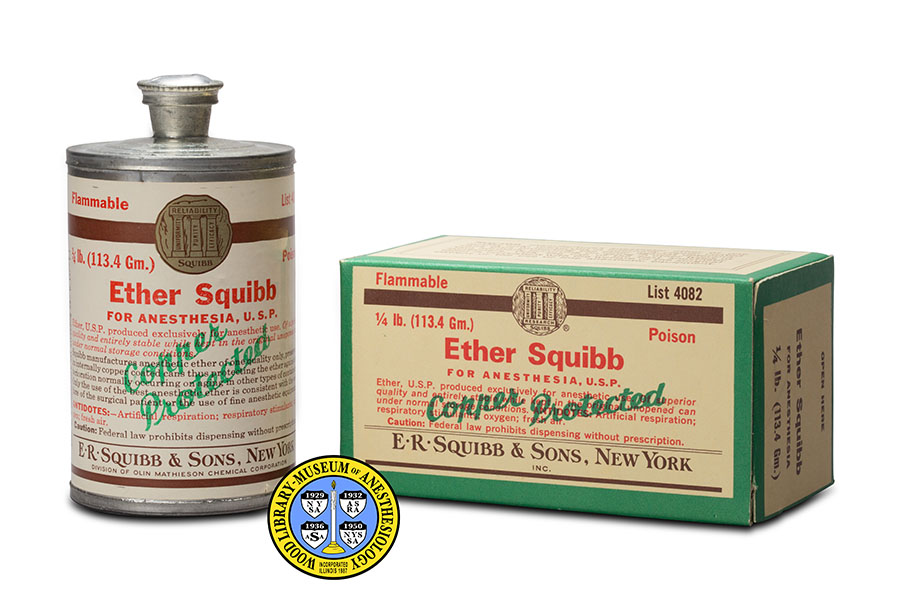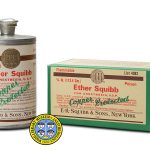Squibb Ether
In 1853, less than a decade after Morton’s public demonstration of ether’s anesthetic properties, physician and chemist Edward Robinson Squibb (1819-1900) began to develop a method for the distillation of ether. He published the details in an 1856 issue of the American Journal of Pharmacy and, in 1858, founded the pharmaceutical company E. R. Squibb in Brooklyn, New York. Ether for surgical anesthesia was the company’s first product.
Ether was still in use when World War II broke out. Although made after WWII, the ether can pictured here is a good example of the type of can produced by Squibb and made available to American military anesthesia providers during the war. Although a wide variety of anesthesia techniques were employed during WWII, inhalation anesthesia with ether was one of the most common. It was generally administered with an anesthesia machine, such as the Ohio 685. However, there were occasions when a working machine was not available and ether was administered via the open drop method. In fact, a Yankauer Mask for open drop anesthesia was among the supplies included in the standard U.S. Army Anesthesia Set.
Ether continued to be used in civilian practice after WWII. Moreover, ether was not completely replaced by newer anesthetic agents until the 1970s, more than 100 years after the first public demonstration of its anesthetic properties.
Catalog Record: Squibb Ether
Access Key: ameb
Accession No.: 2014-02-27-2
Title: Ether Squibb for anesthesia, U.S.P.
Corporate Author: E. R. Squibb & Sons.
Publisher: New York : E. R. Squibb & Sons, [between 1956 and 1968?].
Physical Descript: 1 can : metals, paper ; 10 cm in height by 5.5 cm in diameter.
Subject: Drug Packaging.
Subject: Ether, Ethyl.
Note Type: General
Notes: The following text is printed on the can’s label and on the accompanying box,
“For over one hundred years Squibb Ether has served surgeons, anesthetists
and hospitals in many millions of cases, …”. Based on this statement, the
early year in the date range for the possible year of manufacture of this
ether can is based on the year (1856) that E.R. Squibb first published a
description of his method for producing ether (in the American Journal of
Pharmacy). However, the year that the company was founded was 1858, so the
early year could possibly be narrowed to 1959. Also printed on the can’s
label is the following text, “Division of Olin Mathieson Chemical
Corporation”. Based on this text, the end year in the date range for the
possible year of manufacture is based on the year (1968] that E.R. Squib &
Sons was spun off the Olin Mathieson Chemical Corporation. The date range may
change if documentation, or expert opinion, indicates that it should be
corrected.
Note Type: Citation
Notes: Beecher HK. Anesthesia for men wounded in battle. In: DeBakey ME, ed.; United
States Army Medical Service Historical Unit. Surgery in World War II: General
surgery. Washington, D: Office of the Surgeon General, Department of the
Army; 1955. https://history.amedd.army.
mil/booksdocs/wwii/surgeryinwwii/chapter3.htm. Accessed July 28, 2015.
Note Type: Citation
Notes: Doud EA. Anesthesia. In: Berry FB, ed. Surgery in World War II: Thoracic
Surgery. Vol. 1. Washington, D.C.: Office of the Surgeon General, Department
of the Army; 1963:262. https://history.amedd.army.
mil/booksdocs/wwii/thoracicsurgeryvolI/chapter10.htm. Accessed July 28, 2015.
Note Type: Citation
Notes: Drews J. The history of the pharmaceutical industry: natural substances as
drugs. In: Kramer D, trans. In Quest of Tomorrow’s Medicines. New York:
Springer-Verlag; 1999:28.
Note Type: Citation
Notes: Olin Mathieson Chemical Corporation. Lehman Brothers Collection website.
https://www.library.hbs.edu/hc/lehman/company.
html?company=olin_mathieson_chemical_corporation. Accessed July 27, 2015.
Note Type: Citation
Notes: Squibb, Edward Robinson (1819-1900). In: Van Doren CL, HcHenry R, ed.
Webster’s Guide to American History: A Chronological, Geographical, and
Biographical Survey and Compendium. Springfield, Mass.: G. & C. Merriam Co.;
1971:1242-1243.
Note Type: Citation
Notes: Squibb ER. Spiritus aetheris nitrici. Am J Pharm. July, 1856;4:289-304.
Note Type: Physical Description
Notes: One empty can, and a paperboard box, labeled for ether; The nozzle has two
small puncture holes; It measures approximately 10 cm in height by 5.5 cm in
diameter, except at the neck and nozzle; The nozzle measures approximately 2
cm in diameter at its widest point; The accompanying box, also labeled “Ether
Squibb”, measures approximately 6 x 11 x 6 cm (height x width x depth);
Measurements were taken treating the side with “Ether Squibb” printed in
large red lettering as the ‘front’ of the box; A cork is stored inside the
box; Text on the can’s label includes, “[on upper left] Flammable [on upper
right] List 4032 [new line] Squibb logo [new line] 1/4 lb. (113.4 Gm.) Poison
[new line] Ether Squibb [new line] FOR ANESTHESIA, U.S.P. [new line] Ether, U
S.P. produced exclusively for anesthetic use. Of superior … [new line]
ANTIDOTES:—Artificial respiration; respiratory stimulants; oxygen; fresh air.
[new line] Caution: Federal law prohibits dispensing without a prescription.
[new line] E R SQUIBB & SONS, NEW YORK [new line] DIVISION OF OLIN MATHIESON
CHEMICAL CORPORATION”; In green ink, printed diagonally across the text under
the main, Ether Squibb [new line] FOR ANESTHESIA, U.S.P.”, are the words,
Copper [new line] Protected”; Also printed on the label is, “Squibb Ether
[new line] is and always has been made only in the SQUIBB Laboratories, by
the process originated by Dr. E. R. Squibb, and improved and perfected
exclusively in the Squibb Laboratories. [new line] For over one hundred years
Squibb Ether has served surgeons, anesthetists and hospitals, in many
millions of cases, with utmost satisfaction, affording the greatest safety
and comfort to their patients. [new line] Chemical and physical tests alone
seem inadequate to fully demonstrate superior quality in ether, hence long
clinical experience must complete the evidence of fitness. One hundred years
of clinical experience has demonstrated this outstanding fitness and
acceptance of Squibb Ether. [new line] NOTE Ether shall NOT be used for
anesthesia if opened and exposed to air for 24 hours. [new line] Made in U.S.
A.”; Also printed on the label is, “CAUTION:—Ether is highly flammable. It
should be kept in a cool place and remote from an open flame or sparking
apparatus. When employing the open drop method and using the actual cautery,
remove the ether inhaler and cover the patient’s face with a wet towel. When
employing closed system anesthesia observe suitable anti-static precautions.
[new line] Keep at a temperature not exceeding 25° C. (77° F.)”; The text on
the box includes the text printed on the ether can label, as well as the
following, “SQUIBB manufactures anesthetic ether of one quality only,
preserved in internally copper coated cans thus protecting the ether against
deterioration normally occurring on aging in other types of containers. Only
the use of the best anesthetic ether is consistent with the welfare of the
surgical patient or the use of fine anesthetic equipment.”; Other text on the
box but not on the can’s label includes, “OPEN OTHER END [new line] Ether
Squibb [the following is stamped, new line] FSN 6505-153-8225 [new line]
CONTROL: 8B516″; Additional text on box includes, “OPEN HERE [new line] Ether
Squibb [new line] FOR ANESTHESIA [new line] 1/4 lb. (113.4 Gm.)”.
Note Type: Reproduction
Notes: Photographed by Mr. Steve Donisch on June 4, 2015.
Note Type: Acquisition
Notes: Donated to the WLM in memory of Patrick Sim by Mr. Alex Peck.
Note Type: Historical
Notes: In 1853, less than a decade after Morton’s public demonstration of ether’s
anesthetic properties, physician and chemist Edward Robinson Squibb
(1819-1900) began to develop a method for the distillation of ether. He
published the details in an 1856 issue of the American Journal of Pharmacy
and, in 1858, founded the pharmaceutical company E. R. Squibb in Brooklyn,
New York. Ether for surgical anesthesia was the company’s first product.
Ether was still in use when World War II broke out. Although made after WWII,
the ether can pictured here is a good example of the type of can produced by
Squibb and made available to American military anesthesia providers during
the war. Although a wide variety of anesthesia techniques were employed
during WWII, inhalation anesthesia with ether was one of the most common. It
was generally administered with an anesthesia machine, such as the Ohio 685.
However, there were occasions when a working machine was not available and
ether was administered via the open drop method. In fact, a Yankauer Mask for
open drop anesthesia was among the supplies included in the standard U.S.
Army Anesthesia Set.
Ether continued to be used in civilian practice after WWII. Moreover, ether
was not completely replaced by newer anesthetic agents until the 1970s, more
than 100 years after the first public demonstration of its anesthetic
properties.
Note Type: Publication
Notes: Fitzpatrick E, Eastman NJ. Analgesia and anesthesia in labor. In: Zabriskie’s
Obstetrics for Nurses. 10th ed. Philadelphia: J.B. Lippincott Company;
1960:233-234. [A photograph of a Ether Squibb can along with a Yankauer Mask,
airways, and drop bottle can be found on page 234. There is a short
description of the figure on page 233.]
Note Type: Publication
Notes: Martin DP, Burkle CM, McGlinch BP, Warner ME, Sessler AD, Bacon DR. The Mayo
Clinic World War II short course and its effect on anesthesiology.
Anesthesiology 2006;105(1):209-213. https://anesthesiology.pubs.asahq.
org/Article.aspx?articleid=1923229. Accessed July 28, 2015.
Note Type: Publication
Notes: Martin JS. The teaching of anesthesiology in the army. JAMA.
1942;119(16):1245-1248.
Note Type: Publication
Notes: Parks CL, Schroeder ME. Military anesthesia trainees in WWII at the
University of Wisconsin: their training, careers, and contributions.
Anesthesiology. 2013;118(5):1019-1027. https://anesthesiology.pubs.asahq.
org/article.aspx?articleid=1918571. Accessed July 28, 2015.
Note Type: Publication
Notes: Rothweiler EL. Obstetrical care of the patient. Nursing in Pictures.
Philadelphia: F.A. Davis Company; 1945:K-7. [In a photograph of a “Rectal
Ether Tray” is a box of Ether Squibb.]
Note Type: Publication
Notes: Subcommittee on Anesthesia of Division of Medical Sciences, National Research
Council. Fundamentals of Anesthesia: An Outline. Chicago, Illinois: American
Medical Association Press; 1944.
Note Type: Exhibition
Notes: Selected for the WLM website (noted July, 2015).


